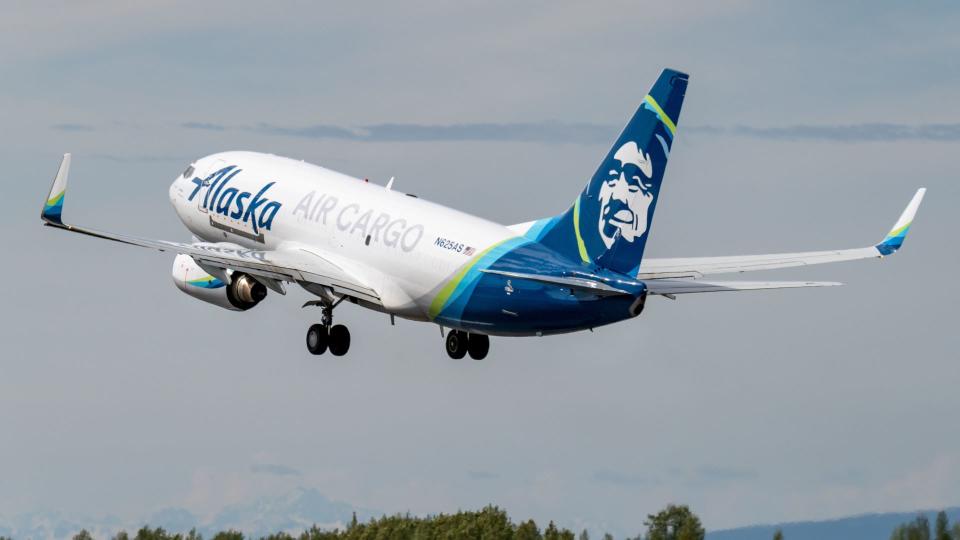Alaska Air to fly Amazon packages after completing Hawaiian buy
Alaska Airlines will take over cargo transportation for e-commerce giant Amazon when it concludes a deal to acquire Hawaiian Airlines' parent in a cash transaction for stock and debt worth $1.9 billion.
Whether the Amazon transportation services agreement is eventually modified is unclear, but Alaska Air Group’s CEO said it could spur further investment in freighters.
“For now, nothing changes,” said Hawaiian Airlines spokesman Alex Da Silva in an email.
Hawaiian Airlines in early October began flying an Airbus A330-300 converted freighter between Amazon’s air logistics superhub at Cincinnati/Northern Kentucky International Airport and its West Coast hub in San Bernardino, California.
Under a contract inked late last year, Amazon plans to lease nine more of the former passenger planes that are being overhauled to carry cargo containers and turn them over to Hawaiian to operate on its behalf in the domestic U.S. market.

The parent company of Alaska Airlines presumably contemplated that Amazon has warrants to take a 15% equity stake in Hawaiian Airlines after nine years conditioned on meeting a spending threshold of $1.8 billion. Operating freighters for the first time in a partnership with Amazon is a way for it to diversify its business.
Alaska Airlines has long operated a small fleet of freighter aircraft, primarily between Alaska and the continental United States. It currently has four converted freighters — three Boeing 737-700s and one 737-800 it received last month.
Boeing is scheduled to deliver a second 737-800 passenger-to-freighter aircraft early next year. But the A330, a medium widebody aircraft, is much larger than the 737 and would bring Alaska’s freighter fleet to 15 aircraft by early 2025.
“We will be closely assessing whether further dedicated freight or flying for ourselves or in an asset light model for others could make sense for the combined company over time,” said Alaska Air CEO Ben Minicucci on a conference call with analysts.
“We haven’t had a ton of conversation with Amazon,” he added. “We’re anxious to understand that more. We are the only passenger carrier in the U.S. industry that has dedicated freighter flying today, removing from three aircraft of five. I think it’s an area of potential longer term opportunity for the company. And we’ll continue to watch to see if that type of flying makes more sense if there’s more of it.”
The Amazon partnership also gives Alaska Airlines a Midwest pilot base and more opportunities for pilots to fly widebody aircraft, which offer more lucrative pay.
“Alaska has a track record of operating a good freighter network and is also an airline known for strong operational reliability. However, the executive team at Hawaiian was strong supporters of the Amazon deal. Many of those leaders may not survive the merger, so Alaska executives will need to prove their commitment to Amazon for the long run,” Derek Lossing, the founder of Cirrus Global Advisors and former Amazon Logistics executive, told FreightWaves.
Executives said on a call with investors that they expect the deal to provide $20 million in redundant savings from cargo operations associated with their respective passenger airlines, which carry cargo in the lower hold as an adjunct business, and potentially unlock further growth.
Bigger is better
The rationale for merging Alaska Airlines and Hawaiian Airlines stems from the fact that they are mid-tier carriers in a competitive US airline market where scale increasingly matters. The deal announced on Sunday would cement Alaska’s place as the fifth largest U.S. airline. Also, Hawaiian has routes to Asia that give Alaska Airlines access to its first major international presence, beyond limited flights to Mexico and Central America.
Alaska Airlines already flies to Hawaii, but will offer expanded service there and count Honolulu as a major hub to tap into the lucrative vacation market there. Hawaiian customers benefit with more direct and one-stop service to more U.S. mainland destinations.
The companies said they will maintain their existing brands, with a combined fleet of 365 aircraft. The Alaska and Hawaiian networks are highly complementary, with only a 3% overlap. Alaska operates an all-Boeing narrowbody fleet while Hawaiian has a mixed fleet that includes 24 A330s and 18 Airbus A321neos.
Alaska appears to have received a good value for its money, with the deal worth less than Hawaiian’s annual revenue and a price-to-earnings ratio of four.
During the first three quarters of 2023, Alaska Airlines generated $10.4 billion in revenue compared to $2.8 billion for Hawaiian.
The transaction is expected to close in 12 to 18 months, pending approval by Hawaiian shareholders and antitrust regulators. But the Justice Department under the Biden administration has taken a hard line against industry consolidation in general, including among airlines. The Justice Department’s antitrust lawsuit against JetBlue’s merger with Spirit Airlines is expected to wrap up in federal court this week.
Click here for more FreightWaves/American Shipper articles by Eric Kulisch.
Contact Reporter: ekulisch@freightwaves.com
RECOMMENDED READING:
Hawaiian Airlines welcomes new Amazon revenue stream
Hawaiian Airlines preps for October start of Amazon cargo service
The post Alaska Airlines to fly Amazon packages after completing Hawaiian buy appeared first on FreightWaves.
